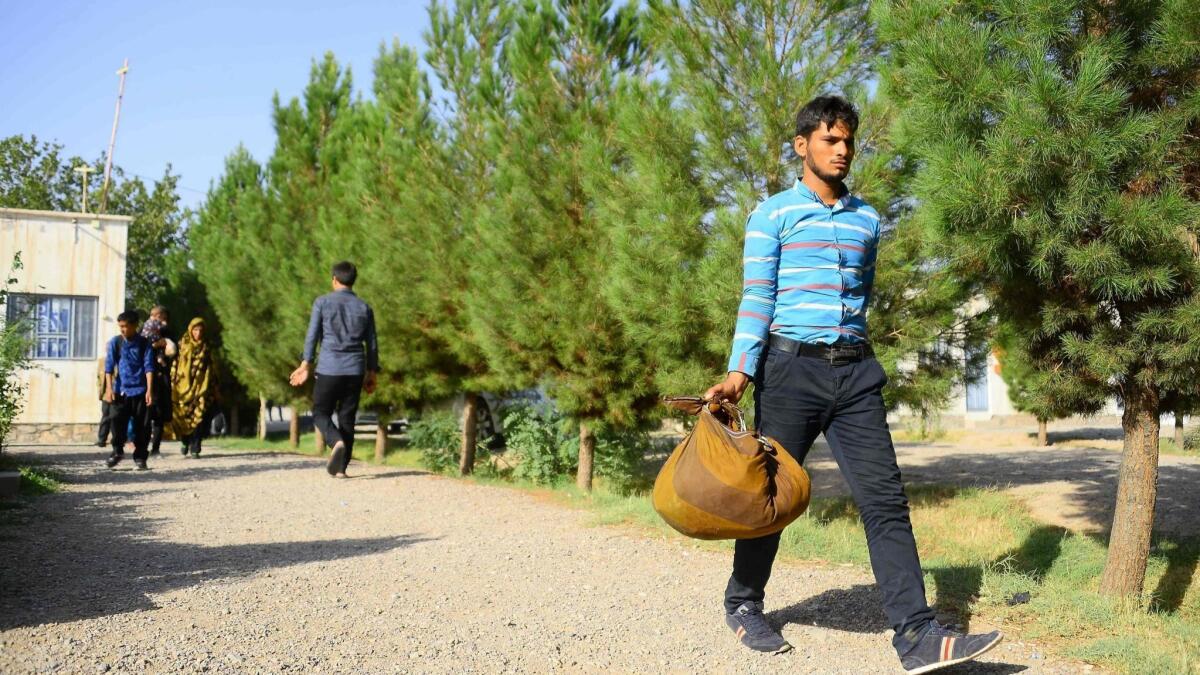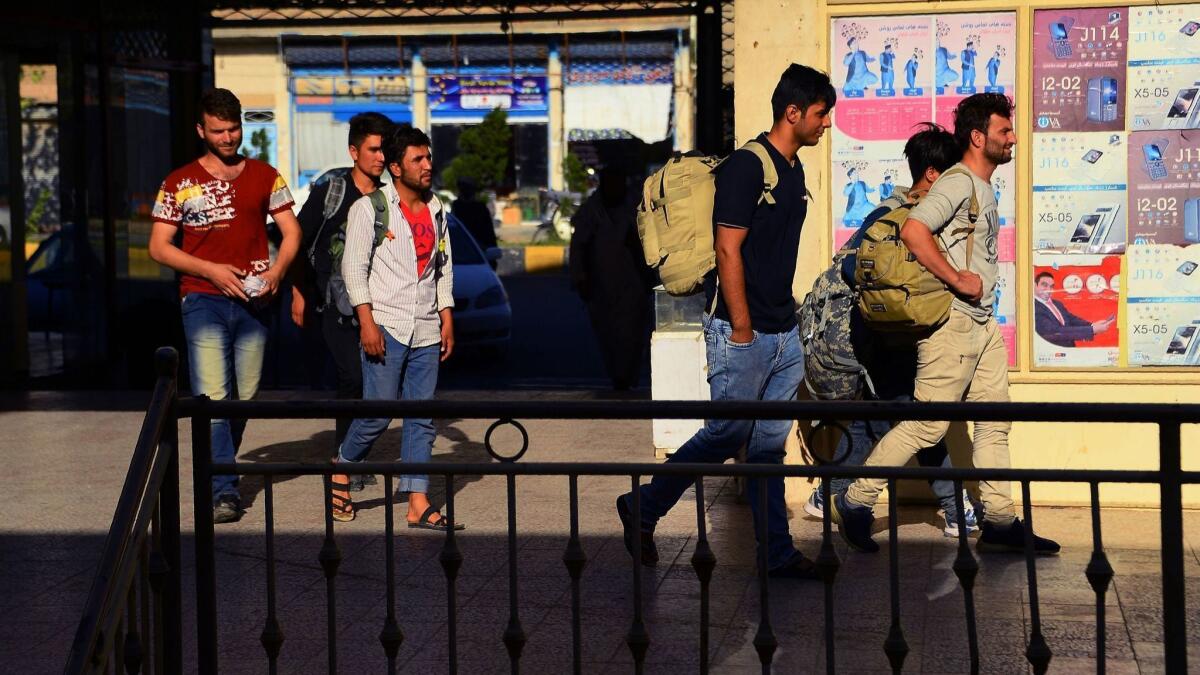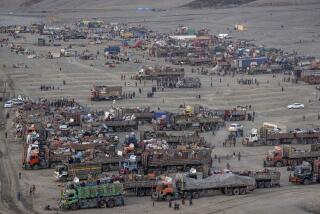U.S. sanctions on Iran are forcing Afghan migrants to return home, to worsening violence

- Share via
Reporting from Tehran — Rahman Kamali, a 30-year-old Afghan who sells vegetables in the Iranian capital, has found a new use for his pickup besides hauling spinach and radishes.
Nearly once a week, another young Afghan migrant climbs into the passenger seat of Kamali’s cream-colored truck and loads his few belongings — mattress, blanket, carpet, maybe a small TV set — into the truck bed.
For about $5, half the usual fare, Kamali drives the men — and they are always young unmarried men — to a depot in the poor southeastern corner of Tehran, where buses leave for the Afghan border.
They are part of a gathering exodus of nearly half a million Afghan migrants who have returned from Iran since January, trading economic turmoil and a currency crisis in the Islamic Republic for the violence and uncertainty of their home country.
President Trump’s sanctions on Iran are spreading gloom across a troubled and drought-stricken region, exacerbating the country’s longstanding problems of inflation and fiscal mismanagement by sparking a run on the currency, the rial, which has lost more than half its value over the past year.
Trump’s withdrawal from a nuclear agreement Iran signed in 2015 with six world powers triggered the renewal of harsh U.S. sanctions, the first of which went into effect this month. A second round of sanctions targeting the oil and financial sectors is due in November.

As bad as Iran’s economy has been for years, it remained a magnet for an estimated 3 million Afghan migrants seeking jobs or a refuge from war. That has begun to reverse, with more than 20,000 Afghans returning from Iran every week, according to the International Organization for Migration.
“The decline of the rial is cutting our purchasing power,” said the stubble-faced Kamali, who is married with three children.
While he has no immediate plans to leave Iran himself, he said the currency crisis was hitting Afghan migrants as hard as Iranians.
Half the Afghans in Iran are there illegally and most are employed in the informal economy — as laborers on construction sites and hawkers of food and agricultural goods — leaving them even more vulnerable to the downturn.
A region-wide drought and the economic crisis have dramatically reduced the demand for such unregulated work as Iranians curtail their spending, watch the value of their savings dissolve and stash their money in foreign currency to guard against the country’s sliding currency.
The small monthly savings that laborers would send home every month to Afghanistan, where the economy is heavily dependent on foreign remittances, have also begun to dry up.
Sayed Aziz Alawi, a 22-year-old Afghan, traveled to Iran with his brother five years ago to find work as laborers; both returned to Kabul six weeks ago. Alawi watched his daily wage of 400,000 rials — which was worth about $10 a year ago — plunge in value to less than $3.50.
“We couldn’t survive,” said Alawi. He and his brother cut down on expenses, dropped chicken from their diet because it grew too costly, and still found subsistence nearly impossible.
“I couldn’t earn money for my family, nor could I afford my own daily expenses if I didn’t work for a day,” he said. “I had to borrow money from my friends most of the time. In the past few months, I lived hand-to-mouth.”
Alawi, who said nearly all his friends had left Afghanistan to seek work in Iran or Turkey, added that he faced discrimination from his Iranian employers, who looked down on Afghans.
He worked on one construction project for a year but wasn’t paid. His boss said he was free to file a complaint, but because Alawi had entered Iran on a one-month visa and overstayed illegally, he could only bite his tongue and look for another job.
Finally, he and his brother turned themselves over to Iranian police and were deported.
His father, Sayed Hasan Alawi, who earns a small income as a social worker, said it had been more than a year since his sons sent money home.
“The money they’re earning in a month there was much less than what they could earn here,” he said. “I told both of them that it’s better to return home. I’d consider sending them back if the value of Iran’s currency rises again — otherwise it’s useless.”

But like many who have returned to Afghanistan, Alawi and his brother are jobless now. Afghanistan’s economy has continued to struggle amid widening attacks by Taliban and Islamic State militants and one of the worst droughts in decades threatening food shortages in two-thirds of the country.
“Less money coming from working males who are instead returning home to no job — combined with drought and resource competition with other returnees — will have a significant impact on the Afghan economy,” said Nicholas Bishop, an emergency response officer with the International Organization for Migration in Kabul.
Officials say the growing ranks of jobless males will make food shortages worse and could potentially fuel conflict.
Among the returnees are Afghans who went to Iran as laborers but ended up being sent to Syria — some effectively drafted, others signing up for religious reasons — to fight in a Shiite Muslim militia known as the Fatemiyoun Division, trained by Iran’s elite Revolutionary Guard. Mostly members of the Hazara ethnic minority, who faced religious discrimination and persecution in Afghanistan, these fighters enjoyed better incomes and residency privileges than most Afghan migrants in Iran.
With the war against Islamic State in Syria winding down, Iran is laying off members of the Fatemiyoun Division, which is believed to have included up to 50,000 Afghans. Ahmad Shuja, an Afghan analyst and editor in chief of the Georgetown Public Policy Review, said that although these men would qualify to remain in Iran, many are deciding it is not worth it.
The addition of large numbers of ex-fighters presents an economic and security challenge for Afghanistan, Shuja said.
“They will be looking for employment, failing which it is not inconceivable that they might use their newfound military experience,” Shuja said. “It is possible that this will first manifest itself in local violence and crime that could conceivably escalate.”
Farhad Omari, a 20-year-old ethnic Uzbek from Afghanistan who works as a plumber’s apprentice in Tehran, said he and his compatriots had nowhere to go.
“We, the Afghan youth, are squeezed by pressures — the violence of the Taliban and Islamic State in our land, the decline of the rial robbing us of our meager savings in Iran,” he said.
While he planned to remain in Iran for the time being, sending money home to his family in eastern Afghanistan’s Paktia province, Omari said, “If the rial continues to fall, I will also go back.”
Special correspondents Mostaghim and Faizy reported from Tehran and Kabul, respectively, and Times staff writer Bengali from Mumbai, India.
Shashank Bengali covers Iran for The Times. Follow him on Twitter at @SBengali
More to Read
Sign up for Essential California
The most important California stories and recommendations in your inbox every morning.
You may occasionally receive promotional content from the Los Angeles Times.











